John Wayne's Army Posts
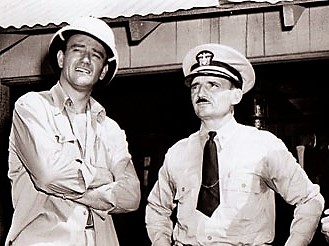
The film dedicated to the forming of the US Naval Construction Battallion, better known as The Fighting Seabees, brought John Wayne to Camp Pendleton near San Diego for the first time. The sprawling, 125-thousand acre Marine Corps base hosted several war movies during World War II. Most of the location filming took place at Iverson Ranch in Chatsworth, however, training scenes with Navy equipment show Camp Rosseau at Port Hueneme, California, homeport of the Seabees. Wayne is seen here with Admiral Lewis B. Combs who served as a technical advisor and formed a lasting friendship with John Wayne (photo courtesy U.S. Navy Seabee Museum).
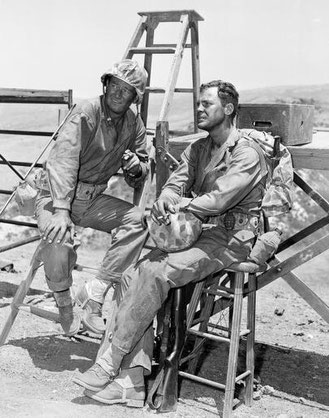
Sands of Iwo Jima brought John Wayne back to Camp Pendleton in the summer of 1949. The camp's vast topography was perfect to recreate the Pacific theatre of World War II. The outdoor set span 2 1/2 miles. The two amphibious landings in the film were re-enacted on the beaches at Camp Del Mar, the Marine amphibious base. Two squadrons of Corsair fighter planes were lent from Marine Air Station at El Toro. John Wayne and his co-stars (seen here with John Agar) stayed at the Carlsbad Hotel, twenty minutes from Pendleton.
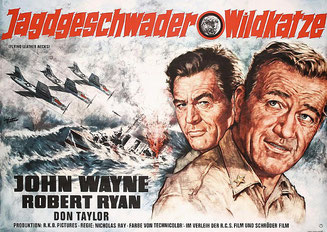
It was back to Pendleton for John Wayne in Flying Leathernecks, lensed from November 20, 1950, to January 27, 1951. The filmmakers again made good use of the Camp's facilities and the Fighter Squadrons stationed at El Toro Air Station. The set designers built a realistic replica of Henderson Field on Guadalcanal.

John Wayne filmed principal photography for Jet Pilot from October 31, 1949, to February 13, 1950. Additional aviation scenes were shot long after Wayne's scenes were wrapped. Howard Hughes' company used Air Force bases in California (March Field, Hamilton Army Air Field and Edwards Air Force Base), in Colorado (Lowry Field), in North Dakota (Fargo Air National Guard Base), in South Dakota (Ellsworth Air Force Base), in Texas (Kelly Field and Lackland Air Force Base), in Florida (Eglin Field), and in Nevada (Reno Stead Airport, Nellis Air Force Base and Pensacola-Eglin Air Force Base).
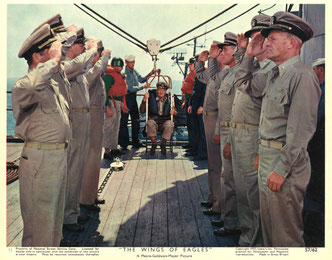
John Ford made it a point to shoot The Wings of Eagles where the story of Frank "Spig" Wead actually began, at the U.S. Naval Air Station in Pensacola, Florida. The poignant ending with John Wayne leaving the ship was filmed at the aircraft carrier U.S.S. Philippine Sea off the coast of South California.
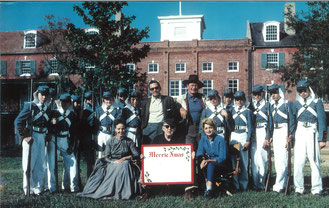
The Horse Soldiers was on location in Mississippi and Louisiana from October 28 to December 5, 1958. Production headquarters was in Alexandria, Louisiana. John Ford used Jefferson Military College in Mississippi for the scene when the cadets charge John Wayne’s cavalry. The historic campus in Natchez is now operated as a museum. John Ford used this photo with the young cadets and his stars, William Holden, Anna Lee and Constance Towers, and for his Christmas card in 1958.

Before settling for Fort Benning as the primary location for The Green Berets, John Wayne, as producer and director of the Vietnam war movie, even considered Army facilities on Okinawa. At the suggestion of the Pentagon, he traveled to Fort Bragg, North Carolina, to get the feel of the place where the Special Forces were trained. But Bragg was ruled out as a location because base officials could not provide a reliable schedule for use of aircraft. It was the Army’s idea to consider Fort Benning. John Wayne himself doubted that he could make Georgia look enough like the Vietnam jungle but Benning regularly had twenty to thirty Huey helicopters in the training program.

John Wayne shot scenes for The Green Berets on the premises of Fort Benning, the largest military base in Georgia, from August 9 to November 15, 1967. He used the Infantry Hall for interiors and Todd Field for barrack inside scenes. Lawson Air Field (seen in this photo) doubled for Da Nang in the scene where the Green Berets arrive in Vietnam. John Wayne, producer and director of the Vietnam war movie, lived with the rest of the cast in the Camellia Motel in Columbus.
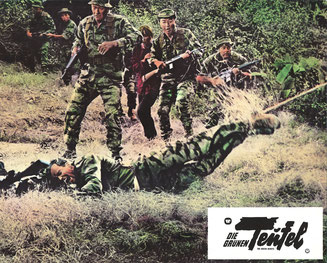
Batjac was permitted to build the sets of „Dodge City“ of The Green Berets and the Vietnamese village in a backwoods area at Benning. Combat footage was shot at a "C Camp" near Kelley Hills. John Wayne captured the parachute landing onto Eubanks Field. The taking of the VC General was filmed at a mansion in the Hilton district of Columbus.
©All text content on this website is protected by copyright and other intellectual property laws. No part may be reproduced without the prior written permission. All photos courtesy of Roland Schaefli, unless otherwise stated.
This website is in no way associated with the John Wayne Estate or business enterprises. Go to johnwayne.com to find the official website and to https://johnwayne.org/ to read about the wonderful John Wayne Cancer Foundation.
more john wayne locations to scout
If you like this site, you'll like the book: the first comprehensive guide to the John Wayne Locations, with hundreds of then-and-now photos, unpublished behind-the-scenes-pictures and detailed tour descriptions
Tracking John Wayne: The complete Tourguide
Find directions to locations and anecdotes from the Duke's movie sets in this new publication from McFarland, available at bookstores and online shops
For all locations mentioned on this website, the book offers behind-the-scenes stories, making-of anecdotes and never before published photos

